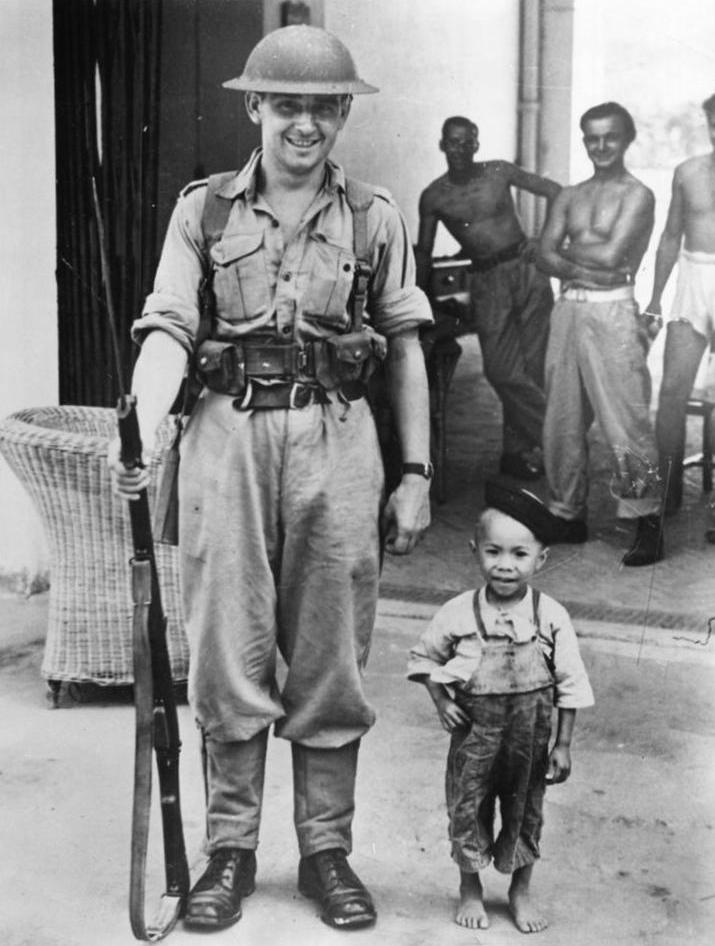
World War II: Japanese Surrender--Shanghai and Hong Kong (1945-46)

Figure 1.-- Here we see a British sentry shiortly after the British reestablished authorities over Hong Kong and acceoted the surrender if thec Japanese garrison at the end of the Pavific War. The press caoption read, "Would-be sentry: The cute little feller with his hat at a jaunty angle is a friendly Chinese lad who decuided to take up sentry duty in Hong Kong. He drew plenty of laughs as ghe stood his watch besude a British Navy sentry." The photograph was dated October 16, 1945.
|
|
The two European outposts in Chuin (Sghanghai and Hong Kong) had different fates after the War. Both were still in Japanese hands when Japan surrendered. The Japanese after attacking Pearl Harbor, moved into the Shanhai International Settlement (December 1941). They formally ended European concessions except for the French. Vichy Franhce at the time was under ythe control of thei German aklies.
The end iof the Internationl Settlements was formally recognized in the Anglo-Chinese Friendship Treaty (1943).
After the Japanese surrendered to the Allies (August 15, 1945), General Douglas MacArthur ordered all Japanese forces within China (except Manchuria, Formosa and French Indochina north of 16° N latitude) to surrender to the Nationalists. The Japanese troops in China formally surrendered (September 9, 1945), but there were no Chinese authorities to surrender to on Hong Kong.
The most immediate concern in both Shanghai and Hong Kong was getting food and other aid to the Western internnes who were being starved by the Japanese. There was also a concern that the Japanese may attemp to kill the interneesas occured at several camps.
The British did not attempt to restablish their Shanghai concession after the War. The French ceded their privileges a year later as their focus shifted to Indchina/Vietnam (1946). The United States Consulate was opened (September 5). Shanghai was, however, not the same city and was soon engulfed in civil war between the Nationalists and Communists. Unlike Shanghai, the British did not relinquish their claim on Hong Kong. Chiang Kai-shek had assumed that his Government would take control of Hong Kong. He had the support of President Roosevelt who believed that colonialism would have to come to an end in the post-War world. He promised Chinese First Lady Soong May-ling during a trip to the United States that Hong Kong would be turned over to Chinese control after the War. [Zhao] Roosevelt was, however, no longer president when the Japanhese surrendered. The British moved decisively after the Japanese surrender. Franklin Gimson, Hong Kong's colonial secretary, had been inprisoned by the Japanese. Upon hearing of the Japanese surrenhder, he walked out of the prison camp and declared himself acting governor. The Japanese recognized his action. He opened an office in Victoria (September 1). The British ordered Rear Admiral Sir Cecil Halliday Jepson Harcourt to Hong Kong. He sailed into Hong Kong harbor on board the Royal Navy cruiser HMS Swiftsure to show the flag. He formally accepted the Japanese surrender (Septemjber 16). The Allies arrested General Takashi Sakai who had commanded the Japese forces which had seized HoingbKong and acted for a time as governor. He was tried as a war criminal and after being found guilty executed (September 30, 1946).
Sources
Zhao, Li and Warren I. Cohen. Hong Kong under Chinese rule: The economic and political implications of reversion (Cambridge University Press: 1997).
HBC

Navigate the Boys' Historical Clothing Web Site:
[Return to Main World War II Chinese-Japanese War page]
[Biographies]
[Campaigns]
[Children]
[Countries]
[Deciding factors]
[Diplomacy]
[Geo-political crisis]
[Economics]
[Home front]
[Intelligence]
[POWs]
[Resistance]
[Race]
[Refugees]
[Technology]
[Bibliographies]
[Contributions]
[FAQs]
[Images]
[Links]
[Registration]
[Tools]
[Return to Main World War II page]
[Return to Main war essay page]
Created: 10:14 AM 6/28/2013
Last updated: 10:14 AM 6/28/2013



